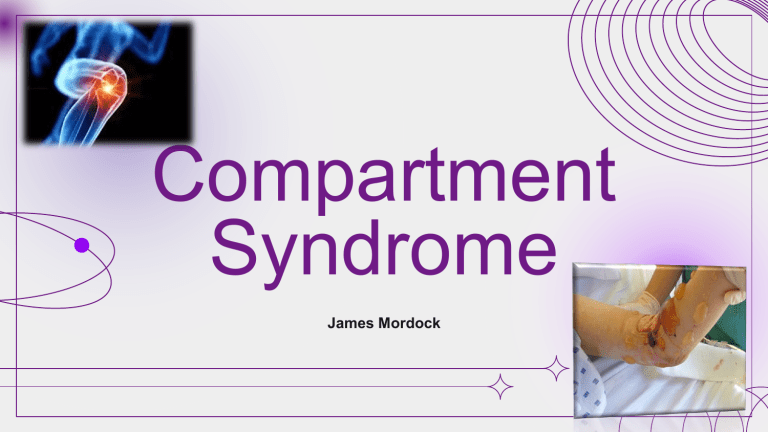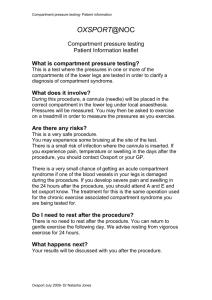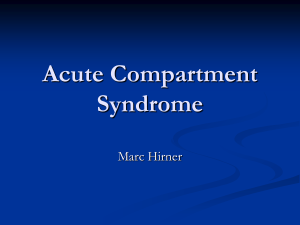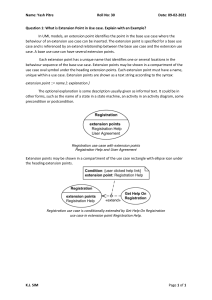
Compartment Syndrome James Mordock Compartment Syndrome What is it? Definition Compartment syndrome is a condition where there is an increased pressure in a muscle compartment that usually leads to an impairment of tissue perfusion. This commonly affects the lower extremities, but it can occur in other extremities or abdomen as well. It is usually categorized as either an acute compartment syndrome (occurs after trauma) and is considered a surgical emergency presenting with rapid progressive pain, paresthesia, and pallor or a chronic compartment syndrome (from excessive training in athletes). Causes of Compartment Syndrome External Compression:● Trauma Causes ○ Burn eschars ○ Constrictive bandage/cast applied before limb has stopped swelling. ● Non-Trauma Causes ○ Prolonged poor positioning of limbs Internal Compression:● Trauma causes ○ Hematoma and Edema from long bone fractures ○ Hemorrhage I muscle compartment ○ Burn Edema ○ Reperfusion syndrome with ischemia ● Non-Trauma Causes ○ Spontaneous bleeding in coagulopathic patients Pathology I. External or internal forces as initiating event II. Increased compartment pressure III. Obstruction of venous outflow and collapse of arterioles IV. Decreased tissue perfusion → lower oxygen supply to muscles V. Irreversible tissue damage (necrosis) to muscles and nerves after 4–6 hours of ischemia Clinical Features Acute compartment syndrome (ACS) rapid progression of symptoms Early presentation Pain Often out of proportion to the extent of injury Worse with passive movement or extension of muscles Tight wood like muscles tender for the touch Paresthesia Tissue swelling Late presentation Muscle weakness to paralysis Cold peripheries Pallor Weak/absent distal pulse Chronic compartment syndrome More common in young athletes and runners Usually effects lower limbs Muscle pain, weakness +swelling worsened with exercise and relieved with rest Paresthesia and numbness Diagnosis Compartment pressure measurement Delta Pressure ≤ 30 mm Hg assists in diagnosis Laboratory Test: Assess for rhabdomyolysis – creatine phosphokinase, renal function tests Imaging: X-Ray Doppler Ultrasound Angiography Pulse Oximetry – Identify limb hypoperfusion Treatment options Compartment Syndrome 1) Surgical Treatments Fasciotomy: relieve pressure and restore 1) Supportive Treatments Eliminate underlying cause perfusion 2) Fibulectomy: if fasciotomy fails 3) Escharotomy: circumferential compression 4) Amputation: WARNING Last Resort 2) Cool and position limb to relieve pressure 3) Monitor & frequent examination with Correction of fluid imbalance 4) Supplemental oxygen 5) Analgesia Complications Muscle and Soft Tissue Necrosis Nerve lesions with paralysis or deficits in sensory and motor nerves Malunion Fractures Volkmann ischemic Contracture Supracondylar Humeral Fracture Thanks! CREDITS: This presentation template was created by Slidesgo, including icons by Flaticon and infographics & images by Freepik





